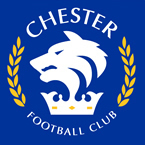| HEADS
AND TALES
The heads in this case
are the alternate ones to be seen on the different
versions of Chester City’s badge. As can
be seen the Chester City emblem consists of a
Wolf’s head (though in some cases it looks
like a Lion); looking over a crown on a castled
rampart surrounded by a circle of leaves (sometimes
Oak, or something else).
Quite how this badge became
to be adapted as the insignia of the football
club, I have no idea, but the elements in the
design have long been associated with the City
of Chester.
The Wolf’s head,
for instance, dates back to Norman times when
the nephew of William the Conqueror, Hugh d’Avranches
was appointed Earl of Chester in 1071. Those were
pretty wild times with much on England still resenting
their new Norman Overlords. Chester was the last
place in the country to be subdued and forced
to ‘knuckle under’ as William took
his army on a tour of devastation and rebel-bashing
in the north of England. The Earl of Chester therefore
needed to be of the tough variety so as to keep
the locals in order and protect the King’s
property from the Welsh.
Hugh d’Avranches seems to have been particularly
ruthless and admirably suited to the job.
According to one commentator
(not John Motson!) “this man [Hugh] with
the help of many cruel barons, shed much Welsh
blood”. Hugh earned the nickname of "Lupus"
which is the Latin name for “Wolf”.
Hence the emblem of the Wolf’s head. Incidentally,
Hugh the Wolf was also known as Hugh the Fat,
for he was at times so gluttonous over food and
drink that he could hardly move!
Although the Prince of Wales
now has the honorary title ‘Earl of Chester’,
and the Grosvenor family have adopted the name
“Lupus”. There used to be a Wolf Gate
in the walls of Chester but it collapsed on the
eve of the second world war, it has been replaced
by the New Gate.
This brings us to the walls
or crown in the football club crest.
There appears some confusion over which it should
be. The walls are an obvious motif – a sign
of Chester’s proud heritage of its City
walls. Walls which withstood the cannons of Cromwell
(but not the bulldozers of the Dept. of Transport
when the ring road was constructed). The crown
may indicate loyalty to the sovereign. Chester
held out for the Royalist cause during the Civil
War. Interestingly, the arms of a Chester family
(Cowper of Overleigh) from 1642 combines the two;
this has a Wolf’s head rising out of a crown
made of red stones as if it were a wall.
The leaves.
Again variations in the badge design make it unclear
as to whether the leaves should be a laurel –
as in a victors crown, or of Oak. Oak has a more
local significance to Chester. Not only is it
a common tree in the area, the oak leaf has been
the symbol of the Cheshire Regiment since they
saved the King’s life while standing beneath
an oak tree at the battle of Dettingen in 1749.
Colin Mansley |
